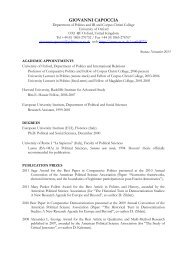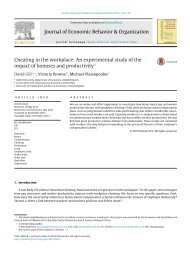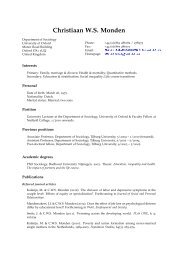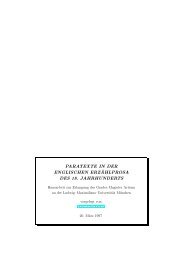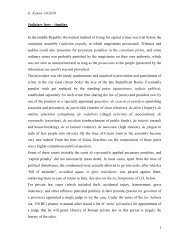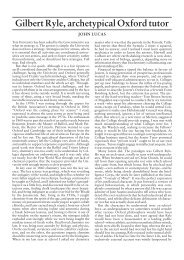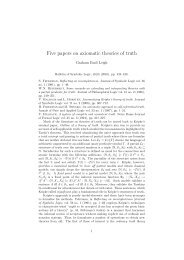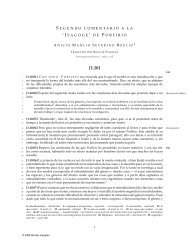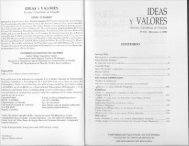Lexical Functional Grammar - Personal Pages Index
Lexical Functional Grammar - Personal Pages Index
Lexical Functional Grammar - Personal Pages Index
Create successful ePaper yourself
Turn your PDF publications into a flip-book with our unique Google optimized e-Paper software.
eral f-structures if the English sentence is ambiguous. For instance, the English<br />
sentenceHans saw the man with the telescope isambiguous: itmeanseitherthat<br />
the man had the telescope or that Hans used the telescope to see the man. The<br />
best translation for this sentence would be a German sentence that is ambiguous<br />
in exactly the same way as the English sentence, if such a German sentence<br />
exists. In the case at hand, we would like to producethe German sentence Hans<br />
sah den Mann mit dem Fernrohr, which has exactly the same two meanings as<br />
the English input. To do this, we map the English f-structures for the input<br />
sentence to the set of corresponding German f-structures; our goal is then to<br />
generate the German sentence Hans sah den Mann mit dem Fernrohr, which<br />
correspondsto each of these f-structures. This approach is linguistically appealing,<br />
but mathematically potentially problematic: Wedekind & Kaplan (1996)<br />
show that determining whether there is a single sentence that corresponds to<br />
each member of a set of f-structures is in general undecidable for an arbitrary<br />
(possibly linguistically unreasonable) LFG grammar. This means that there are<br />
grammars that can be written within the formal parameters of LFG, though<br />
these grammars may not encode the properties of any actual or potential human<br />
language, and for these grammars, there are sets of f-structures for which<br />
it is impossible to determine whether there is any sentence that corresponds to<br />
those f-structures. This result is important in understanding the formal limits<br />
of ambiguity-preserving generation.<br />
Bibliography<br />
Alsina, A. (1993). Predicate Composition: A Theory of Syntactic Function<br />
Alternations. Ph.D. thesis, Stanford University.<br />
Andrews,A., III&Manning, C.D. (1999). Complex Predicates and Information<br />
Spreading in LFG. Stanford, CA: CSLI Publications.<br />
Asudeh, A. (2004). Resumption as Resource Management. Ph.D. thesis, Stanford<br />
University.<br />
Bod, R. & Kaplan, R. M. (1998). ‘A probabilistic corpus-driven model for<br />
<strong>Lexical</strong>-<strong>Functional</strong> analysis.’ In ‘Proceedings of COLING/ACL98: Joint<br />
Meeting of the 36th Annual Meeting of the ACL and the 17th International<br />
Conference on Computational Linguistics, Montréal,’ Association for Computational<br />
Linguistics.<br />
Bresnan, J. (1978). ‘A realistic transformational grammar.’ In Halle, M., Bresnan,<br />
J. & Miller, G. A. (eds.) ‘Linguistic Theory and Psychological Reality,’<br />
Cambridge, MA: The MIT Press.<br />
Bresnan, J. (ed.) (1982). The Mental Representation of Grammatical Relations.<br />
Cambridge, MA: The MIT Press.<br />
Bresnan, J. (2001). <strong>Lexical</strong>-<strong>Functional</strong> Syntax. Oxford: Blackwell Publishers.<br />
24



